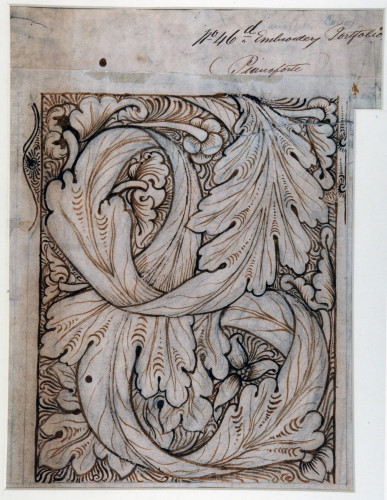This embroidery design features large, curling acanthus leaves – a favourite of Morris and a popular feature of many of his designs for embroidery as well as textiles and wallpaper. Morris’s designs enlarged and foregrounded the acanthus leaf, and for this he likely took some inspiration from ‘Large Leaf Verdure’ tapestries produced in 16th-century France and Belgium. Verdure, or ‘greenery’ tapestries featured exaggerated leaf designs, often with other plants, birds and animals nestled amongst them. They became popular as the designs were easily adapted to different sizes, and the weaving process for the leaf pattern was relatively simple. As a result they could be produced more cheaply, and were therefore available to a wide range of buyers, echoing Morris’ ideals of art and design for all.
The design is numbered No46d in the Firm’s Embroidery Portfolio, another design for part of a pianoforte cover by Philip Webb, numbered 46 is in the collection of the William Morris Society (D88).
Acanthus leaves have been used as inspiration for decorative objects and architectural embellishments as far back as the 5th century, first found in Ancient Greek friezes, roof ornaments and perhaps most prominently in the capitals of Corinthian columns. When Greece came under Roman rule, the aesthetics of Greek decorative arts were brought into Roman architecture and furniture. The acanthus motif was particularly adopted and adapted: the swirling, curling leaves providing a sense of movement and depth to designs. The endurance of the acanthus has partially been credited to the adaptability and hardiness of the plant itself. It has been grown all over the world, used in medicines and for the preservation of food. Conceptually, the leaf has come to symbolise enduring life, immortality and strength.

